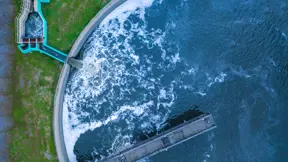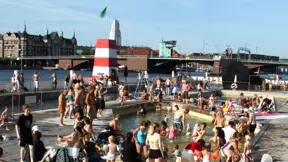
Achieving 50% carbon footprint reduction by 2025
Explore how a water resource recovery facility plans to reduce emissions based on technology assessment and model simulations
West Lafayette’s water resource recovery facility (WRRF) in Indiana, USA, partnered with DHI to assess technology and reduce carbon footprint by 50% before 2025 while achieving better effluent quality. DHI developed a dedicated plan to optimise WRRF operation and validated it by using WEST software for detailed biokinetic process modelling and simulation. The proposed solution for real-time control, digester optimisation and biological phosphorus removal is set to achieve a 60% energy-neutral operation.
Challenge
In 2017, the city mayor of West Lafayette, Indiana, initiated a climate action plan to reduce the city’s carbon footprint. The plan had a special focus on wastewater treatment - one of the highest carbon emission contributors. As part of the plan, the goal set for West Lafayette WRRF is to achieve a 50% reduction in carbon footprint by 2025. This challenged the WRRF to rethink and convert the traditional ways of working in order to operate carbon-neutral processes while being consistently below permitted limits.
To achieve this vision, the WRRF has focused on optimisation of the current operational strategy with minimal modifications to existing plant infrastructure. A new operating strategy was required to achieve stability in effluent quality with the potential to convert the treatment process for near-future modification to Total Nitrogen (TN) discharge limits.
Solution
DHI performed a comprehensive evaluation of current operation of the WRRF to identify the potential for improved efficiency. Potential solutions were tested in a virtual environment using DHI’s WEST software for biological process simulation to quantify the effects and benefits of new operational strategies and process configurations. An optimisation plan was subsequently developed, where priority actions were identified. The provided solution identified the following actions:
- Nutrient-based aeration control
Implementation of turbo-blower speed control using a direct ammonia-based controller to reduce the specific energy and total energy required for aeration. - Biological phosphorus removal
Conversion of a waste-activated sludge (WAS) storage tank into a side-stream fermenter for return activated sludge (RAS). - Anaerobic digester and biogas harvesting optimisation
Use real-time controls and timers to create a steady-state environment for VSS destruction and optimise digester heat and energy balance. - Carbon footprint analysis
DHI developed a carbon footprint calculator for West Lafayette to monitor and track improvements to holistic greenhouse gas emissions in terms of CO2 equivalents.
Client:
Location:
USA
Related SDGs:
SDG 6: Ensure availability and sustainable management of water and sanitation for all
SDG 13: Take urgent action to combat climate change and its impacts
Technology:
Results
The solution resulted in significant effluent quality and energy performance improvements for the WRRF.
Overall, the implementation of the optimisation plan is expected to yield an estimated annual savings of USD 293,000. DHI and West Lafayette are now working to identify low-cost implementation options to fit with the city’s budget for process improvements and carbon footprint reduction fund sources.
- Improved effluent quality: < 10mg/L Total Nitrogen and < 5mg/L Total Phosphorus
- Improved efficiency: 60% energy-neutral operation achievable
- Annual savings: Estimated to be USD 293,000
‘DHI has provided West Lafayette with a roadmap to our goals. Our vision of being energy neutral while still maintaining excellent effluent seems achievable now.’
Dave Henderson
Utility Directory, Water Resource Recovery Facility
City of West Lafayette, Indiana, USA
About our client
The city of West Lafayette WRRF is subject to variable loading caused by seasonal population changes from Purdue University student housing. Among the most densely populated cities in the US, West Lafayette is home to over 30,000 permanent residents. The West Lafayette WRRF treats 7-9 MGD depending on the season for discharge into the Wabash River. The city’s mayor has, as part of the original Paris agreement, initiated a plan to reduce the city’s carbon footprint with focus on wastewater treatment.
You may also like
How can we help?
With our global network of offices, we make sure you get the right answers to your local needs. Tell us about your water challenges and we will get back to you.


